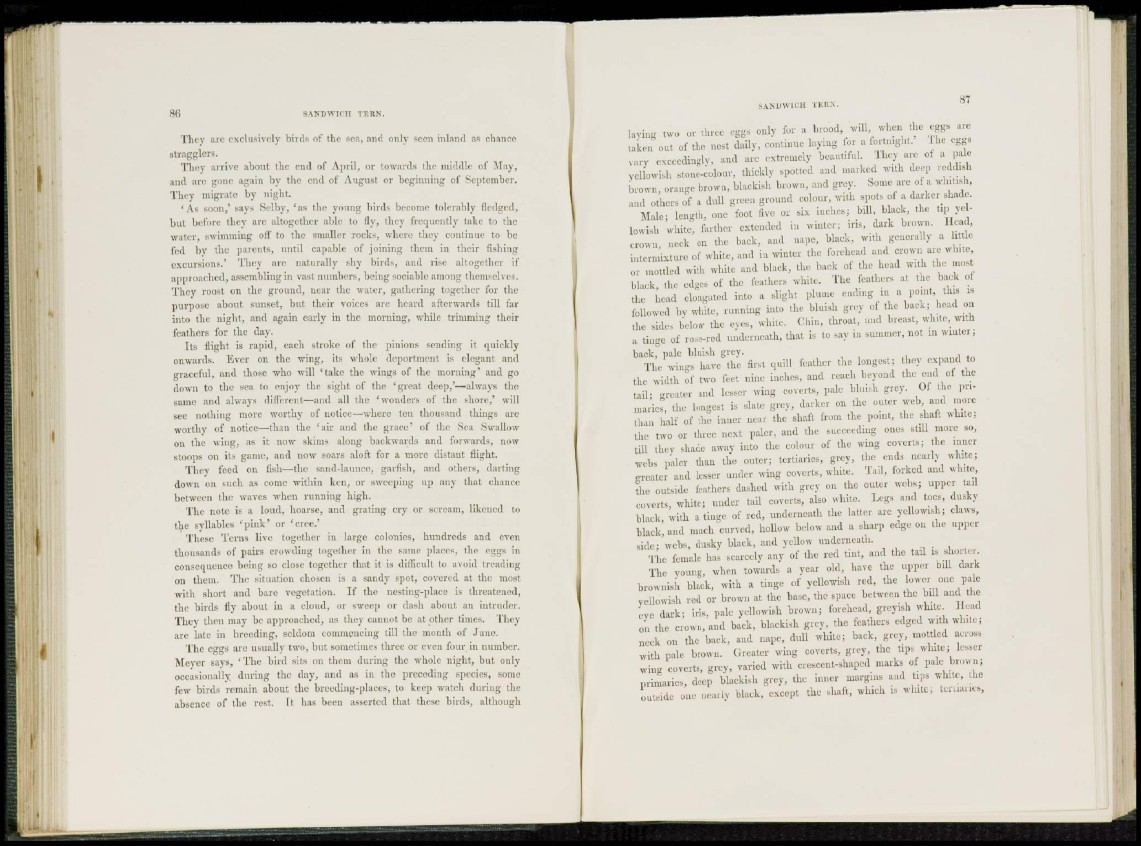
S6 SANDWICH 'I E KN .
They arc exclusively birds of the sea, and only seen inland as chance
stragglers.
They arrive abotit the end of April, or towards the middle of May,
and are gone again by the end of August or beginning of September.
They migrate by night.
' A s soon,* says Selby, ' a s the young birds become tolerably fledged,
but before they are altogether able to fly, they frequently take to the
water, swimming off to the smaller rocks, where they continue to be
Ceil by the parents, until capable of joining them in their fishing
excursions.1 They arc naturally shy birds, and rise altogether if
approached, assembling in vast numbers, being sociable among themselves.
They roost on the ground, near the water, gathering together for the
purpose about sunset, but their voices arc heard afterwards till far
into the night, and again early in the morning, while trimming their
feathers for the day.
Its flight is rapid, each stroke of the pinions sending it quickly
onwards. Ever on the wing, its whole deportment is elegant and
graceful, and those who will ' t a k e the wings of the morning' and go
down to the sea to enjoy the sight of (he 'great deep,'—always the
same and always different—and all the 'wonders of the shore,' will
see nothing more worthy of notice—where ten thousand things are
worthy of notice—than the 'air and the grace' of the Sea Swallow
on the wing, as it now skims along backwards and forwards, now
stoops on its game, and now soars aloft, for a more distant flight.
They feed on fish—the sanddaunce, garfish, and others, darting
down on such as come within ken, or sweeping up any that chance
between the waves when running high.
The note is a loud, hoarse, and grating cry or scream, likened to
the syllables ' p i n k ' or 'cree.*
These Terns live together in large colonies, hundreds and even
thousands of pairs crowding together in the same places, the eggs in
consequence being so close together that it is difficult to avoid treading
on them. The situation chosen is a sandy spot, covered at tin1 most
with short and bare vegetation. If the nesting-place is threatened,
the birds fly about in a cloud, or sweep or dash about an intruder.
They then may be approached, as they cannot be at other times. They
are late in breeding, seldom commencing till the month of June.
The eggs are usually two, but sometimes three or even four in number.
Meyer says, ' T h e bird sits on them during the whole night, but only
occasionally during the day, and as in the preceding species, some
few birds remain about the breeding-places, to keep watch during the
absence of the rest. It has been asserted that these birds, although
laying two or three eggs only for a brood, will, when the eggs are
taken out of the nest daily, continue laying for a fortnight.' The eggs
vary exceedingly, and are extremely beautiful. They are of a pale
yellowish stone-colour, thickly spotted and marked with deep reddish
brown, orange brown, blackish brown, and grey. Some are of a whitish,
and others of a dull green ground colour, with spots of a darker shade.
Male; length, one foot five or six inches; bill, black, the tip yellowish
white, farther extended in winter; iris, dark brown. Head,
crown, neck on the back, and nape, black, with generally a little
intermixture of white, and in winter the forehead and crown are white,
or mottled with white and black, the back of the head with the most
black, the edges of the feathers white. The feathers at the back of
the head elongated into a slight plume ending in a point, this is
followed by white, running into the bluish grey of the back; head on
the sides below the eyes, white. Chin, throat, and breast, white, with
a tinge of rose-red underneath, that is to say in summer, not in winter;
back, pale bluish grey.
The wings have the first quill feather the longest; they expand to
the width of two feet nine inches, and reach beyond the end of the
tail; greater and lesser wing coverts, pale bluish grey. Of the primaries,
the longest is slate grey, darker on the outer web, and more
than hall of the inner near the shaft from the point, the shaft white;
the two or three next paler, and the succeeding ones still more so,
till they shade away into the colour of the wing coverts; the inner
webs paler than the outer; tertiaries, grey, the ends nearly white;
greater and lesser under wing coverts, white. Tail, forked and white,
the outside feathers dashed with grey on the outer webs; upper tail
coverts, white; under tail coverts, also white. Legs and toes, dusk)
black, with a tinge of red, underneath the hitter arc yellowish; claws,
black, and much curved, hollow below and a sharp edge on the upper
side; webs, dusky black, and yellow underneath.
The female has scarcely any of the red tint, and the tail is shorter.
The young, when towards a year old, have the upper bill dark
brownish black, with a tinge of yellowish red, the lower one pale
yellowish red or brown at the base, the space between the bill and the
eye dark; iris, pale yellowish brown; forehead, greyish white. Head
on the crown, and back, blackish grey, the feathers edged with white;
neck on the back, and nape, dull white; back, grey, mottled across
with pale brown. Greater wing coverts, grey, the tips white; lesser
wing coverts, grey, varied with crescent-shaped marks of pale brown;
primaries, deep blackish grey, the inner margins and tips white, the
outside one nearly black, except the shaft, which is white; tertiaries,